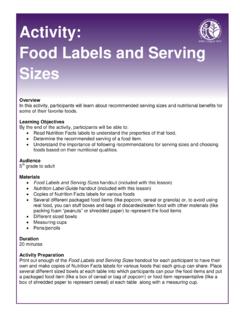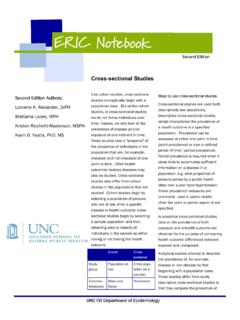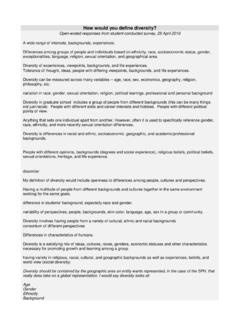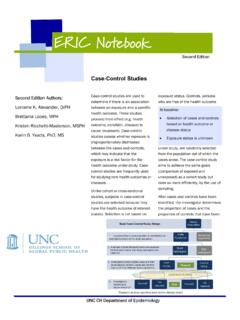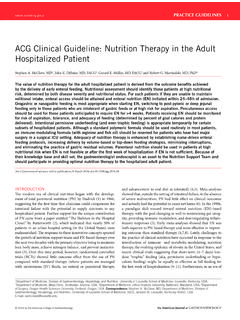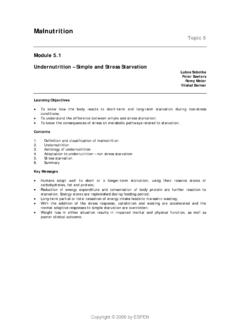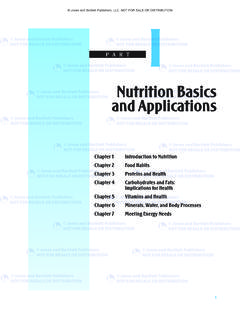Transcription of NUTRITION 642: Medical Nutrition Therapy: Acute Care FALL ...
1 1 Department of NUTRITION School of Public Health University of North Carolina at Chapel Hill NUTRITION 642: Medical NUTRITION therapy : Acute care FALL 2014 I. Course Description A lecture and skills course where students practice skills (such as calculating caloric intake and modifying intake, calculating enteral and parenteral NUTRITION , calculating needs for pediatrics and transplant patients, etc.) under the supervision of a registered dietitian. NUTRITION 600, 630 and 640 or equivalents required as a prerequisite or as a co-requisite. II. Instructor Amanda S.
2 Holliday MS, RD, LDN Office: 241 Rosenau Office Hours: By Appointment Telephone: 966-7214 Email: III. Textbooks Required: Mahan, K. and Escott-Stump, S. UKrause s Food, NUTRITION and Diet TherapyU, 13 PthP Edition Nelms, Long and Lacey. Medical NUTRITION therapy : A Case Study Approach. 4th Edition, 2014. Pronsky, Zaneta M. Food-Medication Interactions. 17 PthP Edition, 2012. IDNT Manual, 4th Edition: Other resources: ADA web site: for Position Papers link (along left side of home page) and other menu items of interest (explore and learn more about the profession) Course podcast can be accessed from Sakai NUTRITION care Manual (22 , username: password: {can be found on sakai} A physiology text and a Medical dictionary IV.)
3 Student Learning Outcomes covered in this course: KRD The curriculum must reflect the scientific basis of the dietetics profession and must include research methodology, interpretation of research literature and integration of research principles into evidence-based practice. KRD The curriculum must include opportunities to understand governancy of dietetics practice, such as the Scope of Dietetics Practice and the Code of Ethics for the Profession of Dietetics; and interdisciplinary relationships in various practice settings. KRD The curriculum must reflect the principles of Medical NUTRITION therapy and the practice of the NUTRITION care process, including principles and methods of assessment, diagnosis, identification and implementation of interventions and strategies for monitoring and evaluation.
4 KRD The curriculum must include the role of the environment, food, NUTRITION and lifestyle choices in health promotion an disease prevention. CRD Diagnose NUTRITION problems and create problem, etiology, signs and symptoms (PES) statements CRD Plan and implement NUTRITION interventions to include prioritizing the NUTRITION diagnosis, formulating a NUTRITION prescription, establishing goals and selecting and managing intervention CRD Monitor and evaluate problems, etiologies, signs, symptoms and the impact of interventions on the NUTRITION diagnosis CRD Complete documentation that follows professional guidelines, guidelines required by health care systems and guidelines required by the practice setting.
5 2 KRD The physical and biological science foundation of the dietetics profession must be evident in the curriculum. Course content my include organic chemistry, biochemistry, physiology, genetics, microbiology, pharmacology, statistics, NUTRITION metabolism and NUTRITION across the lifecycle. V. Learning Experiences 1. Students will independently complete assignments covering varying aspects of the disorders under discussion. 2. Study Guides are provided that will help the student organize information around various disease states. Completion of the study guides is optional for NUTRITION 642 but will be required for the MPH students during NUTRITION 710.
6 3. In the assigned groups, students will work on the case study and lead a discussion of about 20 minutes on the case. 4. Each student who plans to become a registered dietitian in the near future would benefit from developing a Pocket Brain/Cheat Book to be used during supervised practice experiences. This is a collection of material you feel will help you get through your day. Throughout the semester suggestions will be made about what to put in your pocket brain but it is really up to the individual. Pocket brains can be used during the completion of the open book portions of exams in this class.
7 VI. Grading Evaluation of student performance in this course will be based on the following: Learning experiences/assignments 30% Exams (3) 70% Exams in this class are both closed book and open book. The open book exams will be practical work similar to homework assignments. Any reference that you have can be used. Grading Scale: Undergraduates: 1 BGraduates: 97-100 A+ 748-805(>93%) H 93-96 A 603-747 (75-92%) P 90-92 A- 563-602 (70-74%) L 87-89 B+ <563 (Below 70%) F 83-86 B 80-82 B- 77-79 C+ 73-76 C 70-72 C- Below 70 D Below 60 F Honor System: The Honor Code is in effect in this class and all others at the University.
8 I am committed to treating Honor Code violations seriously and urge all students to become familiar with its terms set out at 22 If you have questions, it is your responsibility to ask me about the Code s application. Online Course Evaluation: UNC uses an online evaluation system to assess the quality of instruction and learning of the courses offered. During the last few weeks of the course, an e-mail will notify you that the system is open with a link to access the form. This evaluation system is anonymous. The instructor will only see the aggregate data with any comments at the end of the course after grades are turned in.
9 You will be sent multiple e-mails until it is completed. All exams and assignments must be submitted with the following signed statement: 35 TOn my honor, no unauthorized assistance has been received or given in the completion of this work. 35T Signature: _____ 3 NOTE: THOSE STUDENTS PLANNING TO TAKE NUTRITION 710: clinical NUTRITION PRACTICE DURING SUMMER, MUST RECEIVE A GRADE OF P OR BETTER IN NUTR 642 IN ORDER TO ENROLL. VII. Course Schedule T 8/19 Introduction to the course Planning for NUTR 710: clinical NUTRITION Experience Q & A for 2 PndP year MPH/RD Students and Review of MPH/RD Schedule Th 8/21 Review of Key Areas from MNT I (Estimating Needs, laboratory assessment, documentation, etc.)
10 Text: Krause, Chapter 8 Sakai/Web: 1. The Merck Manual of Diagnosis and therapy , Section 1, Nutritional Disorders: 22 2. Lab Tests Online: 8/25 Alive Inside Showing at the Carolina Theater, Durham NC T 8/26 Fluids and Electrolytes Text: Krause, Chapter 7 Sakai/Web: 1. Acid-Base Tutorial: 2. The Merck Manual of Diagnosis and therapy (review disorders of fluid volume): 22 3. Simmons and Assell Acid-Base basics , Support Line, 23(1), pg. 6-11, 2001 4. Whitmire SJ: NUTRITION -Focused Evaluation and Management of Dynatremias, NUTRITION in clinical Practice.
